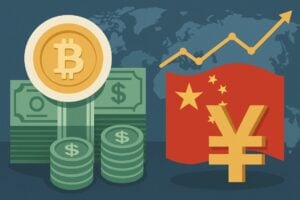Stablecoin is redefining the balance in the global financial system. Over 99% of the total value amounting to 247 billion dollars is indeed denominated in US dollars, leaving alternative currencies with a marginal role.
This trend raises serious strategic questions for China and the future of the yuan in international transactions.
Stablecoin market and devaluation risk for the yuan
The dominance of the dollaro in stablecoin represents a direct challenge to the internationalization of the yuan.
In May 2024, the share of the yuan in cross-border payments stood at 2.89%, the lowest level in the past two years. In comparison, the dollaro continues to hold nearly 48.5% of global transactions through the SWIFT network.
Wang Yongli, former vice head of the Bank of China and co-chairman of the Digital China Information Service Group, emphasized how the expansion of stablecoin pegged to the US dollar represents a strategic threat to the competitiveness of the yuan in international transactions.
If yuan payments are not equally efficient, China risks losing significance on the global monetary scene.
The forecast by Standard Chartered estimates an expansion of the stablecoin market up to 2 trillion dollars by 2028, provided there is clearer and more dynamic regulation.
Consequently, the pressure on China to adapt with its own stablecoin has grown exponentially.
Hong Kong has quickly transformed into a crossroads of experimentation for the regulation of digital assets, including stablecoin.
Its regulatory framework imposes strict safeguards: reserves must be composed of high-quality liquid assets, separated from company funds, and protected from creditors.
Additionally, those who issue stablecoin in Hong Kong must have a minimum capital of 25 million Hong Kong dollars or 1% of the issued value, ensuring financial solidity.
A crucial aspect is the obligation to allow the riscatto of stablecoins at face value within one business day under normal conditions.
These measures aim to protect investors and consumers, but also to consolidate Hong Kong as a regulatory outpost for financial digitalization under institutional control.
Alibaba and JD.com: Strategic Innovation in Digital Assets
Alibaba and JD.com are standing out for their initiatives in creating stablecoins pegged to fiat currencies. In the past, Jingdong Coinlink Technology, a subsidiary of JD.com, tested its own stablecoin in the sandbox promoted by the Hong Kong Monetary Authority.
The product, pegged 1:1 to both the Hong Kong dollar and the US dollar, successfully passed the second phase of testing.
The international division of Ant Group, linked to Alibaba, is also preparing to immediately acquire licenses for stablecoins as soon as the new rules come into effect in Hong Kong.
The intention is to strengthen its presence in the global market, with ongoing license applications in Singapore and Luxembourg. These developments confirm a strategy oriented towards scalability and positioning Asia as a hub of regulated financial innovation.
In 2024, the banks of Hong Kong processed 17.2 billion Hong Kong dollars in digital asset transactions, of which 5.1 billion were in custody at the end of the year.
Ten digital trading platforms have already obtained operational licenses, while eight are in the process of completing their applications.
The institutional attractiveness is also reflected in investment strategies: VMS Group, manager of nearly 4 billion dollars for the wealthiest families in Hong Kong, has allocated 10 million in DeFi strategies of Re7 Capital.
All this demonstrates the growing importance of regulated digital exposures in the financial ecosystem of Hong Kong and, by extension, in the Chinese one.
The rise of stablecoin denominated in dollars, such as USDT, is transforming the landscape of international payments for Chinese companies.
According to Xiao Feng, president of HashKey, Chinese importers are increasingly opting for these digital solutions due to greater efficiency, capital restrictions imposed by China, geopolitical tensions, and currency instability in emerging markets.
This trend highlights a growing reliance on stablecoin pegged to the dollar for cross-border trade, despite the restrictions still present at the domestic level.
JD.com suggests that China allow testing of stablecoin in yuan issuance in Hong Kong, with the intent to then extend the model to other special economic zones.
The underlying goal is to contain dependence on the dollar and maintain monetary sovereignty, at a time when there is also discussion in the United States about possible more favorable regulations and access to regulatory credits for stablecoin projects.
Preserving monetary sovereignty in the era of digital assets
The Chinese government now considers the issuance of a stablecoin in yuan as a strategic response to the threats posed by the growing influence of dollar stablecoins.
The stakes are the possibility of reaffirming the yuan among the reference currencies in the global digital payments landscape.
The moment is particularly delicate. In the United States, a bill in Congress aims to further legitimize cryptocurrencies pegged to the dollar. Consequently, potentially strengthening the primacy of the dollar as the global currency of digital assets.
Clearer U.S. regulation would accelerate this predominance. Thus forcing Beijing to make decisive responses. The battle for control of stablecoin and the preservation of Chinese monetary sovereignty is just beginning.
Alibaba and JD.com position themselves as pioneers, pushing for regulations that favor regulated stablecoin in yuan, positioning Hong Kong and China itself as outposts for the new digital finance.
The next step will be crucial to define the monetary weights in international exchanges and the effectiveness of regulated innovation in countering the supremacy of the dollar in Bitcoin and stablecoin.
The imminent choices may shape the balance of digital currencies in the coming years and redefine leadership in the future of the economia globale.







